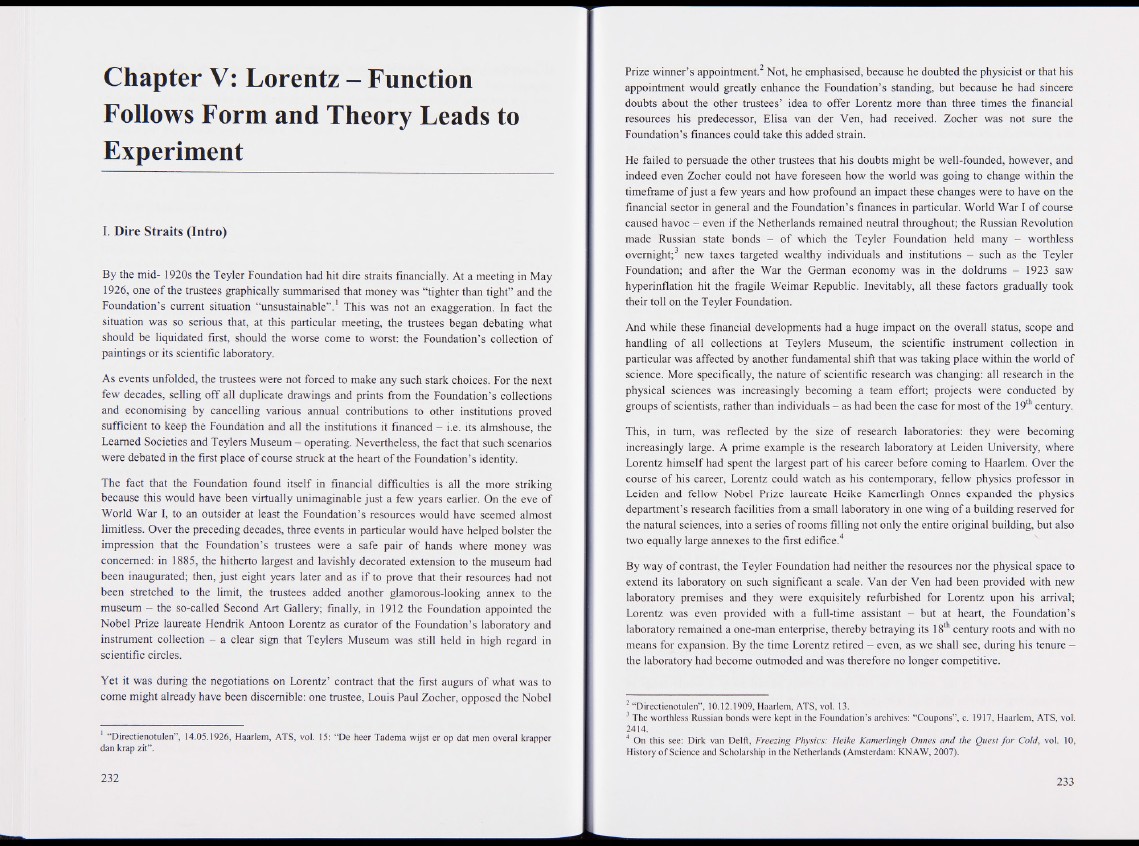
Chapter V: Lorentz - Function
Follows Form and Theory Leads to
Experiment
I. Dire Straits (Intro)
By the mid- 1920s the Teyler Foundation had hit dire straits financially. At a meeting in May
1926, one of the trustees graphically summarised that money was “tighter than tight” and the
Foundation’s current situation “unsustainable”.1 This was not an exaggeration. In fact the
situation was so serious that, at this particular meeting, the trustees began debating what
should be liquidated first, should the worse come to worst: the Foundation’s collection of
paintings or its scientific laboratory.
As events unfolded, the trustees were not forced to make any such stark choices. For the next
few decades, selling off all duplicate drawings and prints from the Foundation’s collections
and economising by cancelling various annual contributions to other institutions proved
sufficient to keep the Foundation and all the institutions it financed l i .e . its almshouse, the
Learned Societies and Teylers Museum - operating. Nevertheless, the fact that such scenarios
were debated in the first place of course struck at the heart of the Foundation’s identity.
The fact that the Foundation found itself in financial difficulties is all the more striking
because this would have been virtually unimaginable just a few years earlier. On the eve of
World War I, to an outsider at least the Foundation’s resources would have seemed almost
limitless. Over the preceding decades, three events in particular would have helped bolster the
impression that the Foundation’s trustees were a safe pair of hands where money was
concerned: in 1885, the hitherto largest and lavishly decorated extension to the museum had
been inaugurated; then, just eight years later and as if to prove that their resources had not
been stretched to the limit, the trustees added another glamorous-looking annex to the
museum — the so-called Second Art Gallery; finally, in 1912 the Foundation appointed the
Nobel Prize laureate Hendrik Antoon Lorentz as curator of the Foundation’s laboratory and
instrument collection - a clear sign that Teylers Museum was still held in high regard in
scientific circles.
Yet it was during the negotiations on Lorentz’ contract that the first augurs of what was to
come might already have been discernible: one trustee, Louis Paul Zocher, opposed the Nobel
“Directienotulen”, 14.05.1926, Haarlem, ATS, vol. 15: “De heer Tadema wijst er op dat men overal krapper
dan krap zit”.
Prize winner’s appointment.2 Not, he emphasised, because he doubted the physicist or that his
appointment would greatly enhance the Foundation’s standing, but because he had sincere
doubts about the other trustees’ idea to offer Lorentz more than three times the financial
resources his predecessor, Elisa van der Ven, had received. Zocher was not sure the
Foundation’s finances could take this added strain.
He failed to persuade the other tmstees that his doubts might be well-founded, however, and
indeed even Zocher could not have foreseen how the world was going to change within the
timeframe of just a few years and how profound an impact these changes were to have on the
financial sector in general and the Foundation’s finances in particular. World War I of course
caused havoc - even if the Netherlands remained neutral throughout; the Russian Revolution
made Russian state bonds — of which the Teyler Foundation held many S worthless
overnight;3 new taxes targeted wealthy individuals and institutions - such as the Teyler
Foundation; and after the War the German economy was in the doldrums -S i923 saw
hyperinflation hit the fragile Weimar Republic. Inevitably, all these factors gradually took
their toll on the Teyler Foundation.
And while these financial developments had a huge impact on the overall status, scope and
handling of all collections at Teylers Museum, the scientific instrument collection in
particular was affected by another fundamental shift that was taking place within the world of
science. More specifically, the nature of scientific research was changing: all research in the
physical sciences was increasingly becoming a team effort; projects were conducted by
groups of scientists, rather than individuals - as had been the case for most of the 19th century.
This, in turn, was reflected by the size of research laboratories: they were becoming
increasingly large. A prime example is the research laboratory at Leiden University, where
Lorentz himself had spent the largest part of his career before coming to Haarlem. Over the
course of his career, Lorentz could watch as his contemporary, fellow physics professor in
Leiden and fellow Nobel Prize laureate Heike Kamerlingh Onnes expanded the physics
department’s research facilities from a small laboratory in one wing of a building reserved for
the natural sciences, into a series of rooms filling not only the entire original building, but also
two equally large annexes to the first edifice.4
By way of contrast, the Teyler Foundation had neither the resources nor the physical space to
extend its laboratory on such significant a scale. Van der Ven had been provided with new
laboratory premises and they were exquisitely refurbished for Lorentz upon his arrival;
Lorentz was even provided with a full-time assistant - but at heart, the Foundation’s
laboratory remained a one-man enterprise, thereby betraying its 181 century roots and with no
means for expansion. By the time Lorentz retired - even, as we shall see, during his tenure 3
the laboratory had become outmoded and was therefore no longer competitive.
2 “Directienotulen”, 10.12.1909, Haarlem, ATS, vol. 13.
3 The worthless Russian bonds were kept in the Foundation’s archives: “Coupons”, c. 1917, Haarlem, ATS, vol.
2414.
4 On this see: Dirk van Delft, Freezing Physics: Heike Kamerlingh Onnes and the Quest fo r Cold, vol. 10,
History o f Science and Scholarship in the Netherlands (Amsterdam: KNAW, 2007).